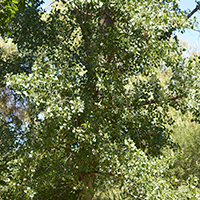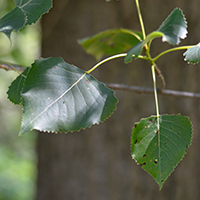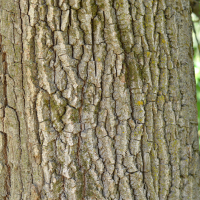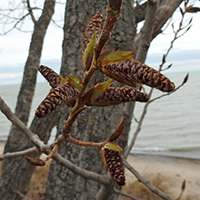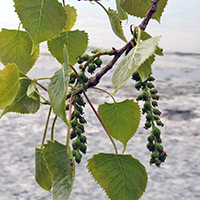What eastern cottonwood looks like
Size and shape
- Reaches 30 metres high.
- Trunk up to 100 centimetres in diameter.
Leaves
- Shiny and green (5 to 10 centimetres).
- Bottoms are pale green.
- Triangular with rounded base and pointy tip.
- Coarsely toothed edges.
Bark
- Smooth and yellow-grey when young.
- Furrowed and dark grey when mature.
Flowers
- Catkins are 5 to 7 centimetres long.
- Develop in May.
Fruit
- Catkins (15 to 25 centimetres) contain small capsules (8 to 12 millimetres).
- Tapered at both ends.
- Split into 3 or 4 parts once mature.
- Contains tufted seeds.
Where eastern cottonwood is found
Eastern cottonwood is uncommon in Ontario but can be found in Southern Ontario near the Great Lakes and St. Lawrence River and in the Lake of the Woods area in Northwestern Ontario.
What you need to know to grow eastern cottonwood
- Moisture: grows best in well-drained, moist sites, typically around stream banks, but can tolerate dry to moderately wet soils and is adapted to growing on floodplains.
- Soil: grows best in sandy soils but tolerates a variety of soils.
- Shade: requires full sun.
- Cautions:
- Planting: eastern cottonwood has soft wood, making it susceptible to wind and ice damage. It should not be planted near buildings.
Benefits and uses of eastern cottonwood
Wildlife benefits
Eastern cottonwood is valuable to many species:
- It is a favorite of beavers, who use these trees for building materials and food.
- Its leaves are high in protein and can be harvested as feed for cattle and chickens.
- Squirrels eat the catkins.
Commercial uses
Eastern cottonwood has soft wood and is commonly used for:
- plywood
- pulpwood
- chipboard
It is not often used as a landscape or shade tree due to its weak wood, but its fast growth can make it a desirable windbreak tree.
Fun facts about eastern cottonwood
- Eastern cottonwood can grow almost 50 metres in less than 30 years.
- It gets its name from the cotton-like hairs attached to its seeds.
- It often hybridizes with other poplar species, which can make tree identification difficult.
Updated: January 10, 2024
Published: August 22, 2023
